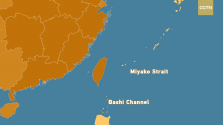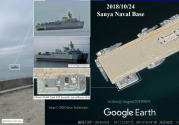You are using an out of date browser. It may not display this or other websites correctly.
You should upgrade or use an alternative browser.
You should upgrade or use an alternative browser.
PLAN ASW Capability
- Thread starter shen
- Start date
Not PLAN specifically, but can anyone see the obvious potential of this technology?
broadsword
Brigadier
Not PLAN specifically, but can anyone see the obvious potential of this technology?
Will it be able to survey a vast swathe in one swipe?
One of these is operating around Sanya. Was this ship escorting the Shandong?
Hendrik_2000
Lieutenant General
I guess China is ramping ASW now that they have quite a number of KQ200
An aviation unit of the China navy has improved its capabilities in winning anti-submarine warfare via drills featuring real-combat conditions and cross-units coordination.
According to Taiwan's , many of those flights take place off of southwest Taiwan and include variants of the Shaanxi Y-8 aircraft equipped for reconnaissance or anti-submarine warfare.
The latter capability is particularly important in those waters, where the shallow Taiwan Strait meets the deeper South China Sea. To the east, the Bashi Channel connects them to the Pacific through the Philippine Sea.

A Chinese submarine off the coast of Qingdao in Shandong province, April 23, 2009. REUTERS/Guang Niu/Pool
The South China Sea's deep waters are "favorable" for Chinese submarine activity, and the proximity to Taiwan is the reason for "the frequent presence" of anti-submarine aircraft, said Su Tzu-yun, director of the defense strategy and resource division at the Institute for National Defence and Security Studies, a Taiwanese state-backed think-tank.
The Bashi Channel "can be considered as an underwater corridor from which Chinese submarines can enter the Philippine Sea and launch strikes against the US West Coast," Su told Insider.

Operating and detecting submarines in that area depends on knowledge of water conditions there, which China is working to learn.
"If you want to fight a successful naval war, you had better get your hydrographic information right," said Lyle Goldstein, a research professor and expert on Chinese undersea warfare at the US Naval War College.
That information affects algorithms used in undersea warfare, and China has been "pulling out all the stops" to understand the currents, temperature, and salinity of those waters, Goldstein told Insider.
"The performance of all those systems is affected by those algorithms, and the Chinese know that," Goldstein said, "They are working absolutely overtime."
Shiyu, or Lion Islet, one of Taiwan's offshore islands, seen in front of the Chinese city of Xiamen, April 20, 2018. Carl Court/Getty Images
The geography around the first island chain - the islands immediately off East Asia, including Japan, Taiwan, and the Philippines - creates challenges and opportunities for submarine warfare.
"China has this kind of perennial strategic problem of geography," Goldstein said. "To egress their submarines is quite difficult because they have to maneuver through the island chains."
"You can bet they're working very hard on making it as hard as they can for the US to know when Chinese submarines are going out and how they do it," Goldstein added.
The shallowness of the Taiwan Strait inhibits submarine operations, but the currents, temperatures, and salinity create "a really tough acoustic environment," according to Bryan Clark, an expert on naval warfare at the Hudson Institute and a former submarine officer.
The latter conditions make it harder to detect submarines - an acute problem for US forces tasked with finding Chinese subs in a conflict. The Chinese, however, will likely "just wait for the US [submarines] to start doing something that they can detect," such as firing torpedoes or missiles, Clark said.
China has rolled out an array of assets that improve its ability to do that, including anti-submarine-warfare , , and advanced helicopters and fixed-wing aircraft.

Huizhou, a Chinese Navy Type 056 corvette designed for coastal defense, near Hong Kong, July 7, 2017. Roy Issa/South China Morning Post via Getty Images
"China just in the last five years has started fielding units of serious anti-submarine aircraft," Goldstein said, citing the Gaoxin-6, an improved anti-submarine variant of the Y-8/9 aircraft.
"They had helicopters that could do anti-submarine warfare, but this is quite new, to have these large fixed-wing planes that drop on sonobuoys and look for submarines," Goldstein added.
China still has anti-submarine-warfare shortcomings. Its sonar and sonobuoys "aren't very sophisticated," Clark said. "They're easily two generations behind where the US and NATO are and ... at least one generation behind Japan."
The combination of assets and capabilities likely means China will focus on thwarting offensive operations by US subs rather than proactively hunting them, Clark said. Despite US submarines' familiarity with the area, the confined waters there would limit their ability to evade attacks, meaning they'd likely back off in the face of Chinese pressure.
"The idea would be if a potential submarine is detected, they would send these aircraft, like the Y-8, out there to drop weapons on them," Clark said. "They're going to make sure that their own submarines are not in the area and use that to suppress US submarine operations."
"The fact that the Chinese are developing this, essentially, [anti-submarine warfare] response capability means that US submarines are going to have a more limited impact on any confrontation with the Chinese over something like Taiwan," Clark added.

US Navy fast-attack submarine USS Asheville with US 7th Fleet flagship USS Blue Ridge in the Philippine Sea. US Navy/MC2 Adam K. Thomas
China's efforts to improve its maritime awareness aren't limited to waters around Taiwan.
Last year, Australian officials a Chinese ship off that country's western coast was likely mapping routes Australian subs use to access the South China Sea. In December, Indonesian fisherman found a suspected Chinese underwater drone, which was as a sign of China trying gather information needed for submarine operations near Australia.
An aviation unit of the China navy has improved its capabilities in winning anti-submarine warfare via drills featuring real-combat conditions and cross-units coordination.
According to Taiwan's , many of those flights take place off of southwest Taiwan and include variants of the Shaanxi Y-8 aircraft equipped for reconnaissance or anti-submarine warfare.
The latter capability is particularly important in those waters, where the shallow Taiwan Strait meets the deeper South China Sea. To the east, the Bashi Channel connects them to the Pacific through the Philippine Sea.

A Chinese submarine off the coast of Qingdao in Shandong province, April 23, 2009. REUTERS/Guang Niu/Pool
The South China Sea's deep waters are "favorable" for Chinese submarine activity, and the proximity to Taiwan is the reason for "the frequent presence" of anti-submarine aircraft, said Su Tzu-yun, director of the defense strategy and resource division at the Institute for National Defence and Security Studies, a Taiwanese state-backed think-tank.
The Bashi Channel "can be considered as an underwater corridor from which Chinese submarines can enter the Philippine Sea and launch strikes against the US West Coast," Su told Insider.

Operating and detecting submarines in that area depends on knowledge of water conditions there, which China is working to learn.
"If you want to fight a successful naval war, you had better get your hydrographic information right," said Lyle Goldstein, a research professor and expert on Chinese undersea warfare at the US Naval War College.
That information affects algorithms used in undersea warfare, and China has been "pulling out all the stops" to understand the currents, temperature, and salinity of those waters, Goldstein told Insider.
"The performance of all those systems is affected by those algorithms, and the Chinese know that," Goldstein said, "They are working absolutely overtime."
Waiting game
Shiyu, or Lion Islet, one of Taiwan's offshore islands, seen in front of the Chinese city of Xiamen, April 20, 2018. Carl Court/Getty Images
The geography around the first island chain - the islands immediately off East Asia, including Japan, Taiwan, and the Philippines - creates challenges and opportunities for submarine warfare.
"China has this kind of perennial strategic problem of geography," Goldstein said. "To egress their submarines is quite difficult because they have to maneuver through the island chains."
"You can bet they're working very hard on making it as hard as they can for the US to know when Chinese submarines are going out and how they do it," Goldstein added.
The shallowness of the Taiwan Strait inhibits submarine operations, but the currents, temperatures, and salinity create "a really tough acoustic environment," according to Bryan Clark, an expert on naval warfare at the Hudson Institute and a former submarine officer.
The latter conditions make it harder to detect submarines - an acute problem for US forces tasked with finding Chinese subs in a conflict. The Chinese, however, will likely "just wait for the US [submarines] to start doing something that they can detect," such as firing torpedoes or missiles, Clark said.
China has rolled out an array of assets that improve its ability to do that, including anti-submarine-warfare , , and advanced helicopters and fixed-wing aircraft.

Huizhou, a Chinese Navy Type 056 corvette designed for coastal defense, near Hong Kong, July 7, 2017. Roy Issa/South China Morning Post via Getty Images
"China just in the last five years has started fielding units of serious anti-submarine aircraft," Goldstein said, citing the Gaoxin-6, an improved anti-submarine variant of the Y-8/9 aircraft.
"They had helicopters that could do anti-submarine warfare, but this is quite new, to have these large fixed-wing planes that drop on sonobuoys and look for submarines," Goldstein added.
China still has anti-submarine-warfare shortcomings. Its sonar and sonobuoys "aren't very sophisticated," Clark said. "They're easily two generations behind where the US and NATO are and ... at least one generation behind Japan."
The combination of assets and capabilities likely means China will focus on thwarting offensive operations by US subs rather than proactively hunting them, Clark said. Despite US submarines' familiarity with the area, the confined waters there would limit their ability to evade attacks, meaning they'd likely back off in the face of Chinese pressure.
"The idea would be if a potential submarine is detected, they would send these aircraft, like the Y-8, out there to drop weapons on them," Clark said. "They're going to make sure that their own submarines are not in the area and use that to suppress US submarine operations."
"The fact that the Chinese are developing this, essentially, [anti-submarine warfare] response capability means that US submarines are going to have a more limited impact on any confrontation with the Chinese over something like Taiwan," Clark added.
'China is extremely worried'

US Navy fast-attack submarine USS Asheville with US 7th Fleet flagship USS Blue Ridge in the Philippine Sea. US Navy/MC2 Adam K. Thomas
China's efforts to improve its maritime awareness aren't limited to waters around Taiwan.
Last year, Australian officials a Chinese ship off that country's western coast was likely mapping routes Australian subs use to access the South China Sea. In December, Indonesian fisherman found a suspected Chinese underwater drone, which was as a sign of China trying gather information needed for submarine operations near Australia.
Last edited:
The latter conditions make it harder to detect submarines - an acute problem for US forces tasked with finding Chinese subs in a conflict. The Chinese, however, will likely "just wait for the US [submarines] to start doing something that they can detect," such as firing torpedoes or missiles
Is that true? I doubt that China would let the US submarines travel unimpeded. Would they just sit back and wait for the US subs to take offensive action?The combination of assets and capabilities likely means China will focus on thwarting offensive operations by US subs rather than proactively hunting them
I dont think playing only defence in a sub game will do China any good. The USN subs knowing the unfavourable environment will surely not expose their location for making quick hits on non-critical targets. So its better for China to actively hunt them to avoid casualties and allow for more freedom of action in the area
Hendrik_2000
Lieutenant General
I don't think so It is his opinion But China has deployed low frequency sonar in SURRTASS in Hainan.So they are actively pinging those Sub Now they are building the 4th ship So their ASW is growing But you still need training to hone the crew in finding those Sub. It is cooperative effort Sosus, Surtass. MPA, Fighter jet, Data fusion, etcIs that true? I doubt that China would let the US submarines travel unimpeded. Would they just sit back and wait for the US subs to take offensive action?
I dont think playing only defence in a sub game will do China any good. The USN subs knowing the unfavourable environment will surely not expose their location for making quick hits on non-critical targets. So its better for China to actively hunt them to avoid casualties and allow for more freedom of action in the area

Seems like a lot of bullshit to me, why would China not want their own subs in the area? You use subs to hunt subs.Is that true? I doubt that China would let the US submarines travel unimpeded. Would they just sit back and wait for the US subs to take offensive action?
I dont think playing only defence in a sub game will do China any good. The USN subs knowing the unfavourable environment will surely not expose their location for making quick hits on non-critical targets. So its better for China to actively hunt them to avoid casualties and allow for more freedom of action in the area
Hendrik_2000
Lieutenant General
Could you elaborate on the role of fighter jet please?I don't think so It is his opinion But China has deployed low frequency sonar in SURRTASS in Hainan.So they are actively pinging those Sub Now they are building the 4th ship So their ASW is growing But you still need training to hone the crew in finding those Sub. It is cooperative effort Sosus, Surtass. MPA, Fighter jet, Data fusion, etc
View attachment 71029


